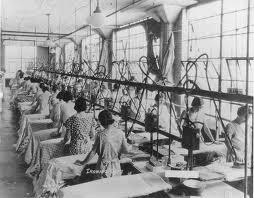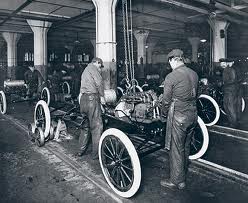As work in factories was becoming increasingly divided and fragmented and companies grew into large-scale joint stock companies, professional managers increasingly took over the running of the companies from the capitalist owners. These professional managers sought to rationalise production and increase the company’s competitiveness. At the same time they had to deal with union disquiet and large numbers of untrained rural people pouring into the cities and into their workforces.
 The aim of industrial managers working for these firms in the later part of the nineteenth century and early first part of the twentieth century was to find ways to control dissatisfied workers and ensure their productivity. Frederick Winslow Taylor (pictured) was one of several engineers experimenting with ways of speeding up production. He invented scientific management, which rather was the “most conscious and systematic expression of the existing trends in the organization of work”.
The aim of industrial managers working for these firms in the later part of the nineteenth century and early first part of the twentieth century was to find ways to control dissatisfied workers and ensure their productivity. Frederick Winslow Taylor (pictured) was one of several engineers experimenting with ways of speeding up production. He invented scientific management, which rather was the “most conscious and systematic expression of the existing trends in the organization of work”.
Taylor came from a well-to-do Quaker/Puritan family. He was well endowed with a Protestant work ethic, lived an ascetic life style, and considered work “as the greatest blessing which we have”. He applied to his own life the schedules, routines and scientific management that he sought to introduce into the workplace.
Taylor’s study of scientific management was aimed at overcoming the workers’ lack of work e thic, which resulted in high rates of absenteeism and workers doing as little work as they could get away with. This was referred to as ‘soldiering’ in the US, ‘hanging it out’ in England and ‘ca canae’ in Scotland. Taylor claimed that “this constitutes the greatest evil with which the working-people of both England and America are now afflicted”. To combat it Taylor sought to reduce the discretion available to workers about how they did their work and thereby increase their productivity.
thic, which resulted in high rates of absenteeism and workers doing as little work as they could get away with. This was referred to as ‘soldiering’ in the US, ‘hanging it out’ in England and ‘ca canae’ in Scotland. Taylor claimed that “this constitutes the greatest evil with which the working-people of both England and America are now afflicted”. To combat it Taylor sought to reduce the discretion available to workers about how they did their work and thereby increase their productivity.
The way that most managers at the time tried to increase productivity was to offer incentives to work harder, such as payment according to how much a worker produced (piece rates). Taylor’s scientific management was, he argued, a more certain way of improving productivity which did not rely on individual workers chasing incentives. Scientific management was based, according to Taylor in his 1911 book Principles of Scientific Management, on four principles:
 Scientific management could, argued Taylor, increase productivity by two or sometimes even three times, meaning a smaller and therefore cheaper workforce. There was at the same time a growth in clerks and officer workers and lower levels of management to plan and schedule work, order and maintain equipment, and supervise the workers.
Scientific management could, argued Taylor, increase productivity by two or sometimes even three times, meaning a smaller and therefore cheaper workforce. There was at the same time a growth in clerks and officer workers and lower levels of management to plan and schedule work, order and maintain equipment, and supervise the workers.
Taylor argued that the thinking part of the work could be better carried out by more intelligent and educated people sitting at desks and that the sort of person who did the planning and thinking should be a quite different sort of person from the one who actually did the work. He said:
The managers assume, for instance, the burden of gathering together all the traditional knowledge which in the past has been possessed by the workmen and then of classifying, tabulating, and reducing this knowledge to rules, laws, and formulæ which are immensely helpful to the workmen in doing their daily work.
All the worker needed to do was follow instructions about what to do, how to do it and how much time to spend doing it. Their cooperation was enforced through close monitoring and control by management. Taylor had little respect for the thinking abilities of the manual worker. He described the work of handling pig iron:
This work is so crude and elementary in its nature that the writer firmly believes that it would be possible to train an intelligent gorilla so as to become a more efficient pig-iron handler than any man can be. Yet it will be shown that the science of handling pig-iron is so great and amounts to so much that it is impossible for the man who is best suited to this type of work to understand the principles of this science, or even to work in accordance with these principles without the aid of a man better educated than he is.
Selecting the right sort of workers was an essential part of Taylor’s scheme. Taylor managed to get a carefully chosen man to handle 47.5 tons of pig iron a day. However, even using the scientific methods Taylor developed, seven out of eight of the men employed as pig-iron handlers could not meet this output and were shifted to other work or dismissed. Taylor argued that the type of man who could shift this amount of pig-iron in a day was “no rare specimen of humanity, difficult to find and therefore very highly prized. On the contrary, he was a man so stupid that he was unfitted to do most kinds of laboring work, even.”
When he applied his methods to a bicycle ball factory, Taylor admitted that this scientific management “involved laying off many of the most intelligent, hardest working, and most trustworthy girls merely because they did not possess the quality of quick perception followed by quick action”. In this factory he eliminated the play and talk between the women, seating them out of talking distance from one another.
In reducing the activity of workers to the bare necessities of the task in hand and removing any thought or skill from that task Taylor removed the more desirable and challenging parts of the work and made it monotonous, tedious and unremittingly boring. Taylor recognised that “The man who is mentally alert and intelligent is for this very reason entirely unsuited to what would, for him, be the grinding monotony of work of this character.” But he argued that the unskilled worker was not harmed by the monotonous work because he was stupid.
Not all engineers were convinced by this argument however. An editorial in The Engineer stated: “We do not hesitate to say that Taylorism is inhuman. As far as possible it dehumanizes the man, for it endeavours to remove the only distinction that makes him better than a machine—his intelligence.”
Scientific management was a key development leading to the eradication of the “surviving remnants of ancient work values”. For example, Ed Andrew points out in his book Closing the Iron Cage:
The skilled artisan who had oiled and repaired his machine, tightened its belting, adjusted the speed and cutting angle of his machine and ground his own tools became, after Taylor’s innovations, a semi-skilled machine operative mechanically executing the directions of the planning department... Thus the varied work of skilled machinists who made their own tool and were attached to the machine whose operations they determined was transformed into a standardized function of a replaceable unit within the machine shop.
Any pride that a worker might have felt in their work was destroyed as tasks were broken up and any individuality removed from manual work. However, Taylor didn’t recognise this deskilling as a major reason for the industrial unrest scientific management was causing. He believed that scientific management could solve the conflict between employers and workers by maximising the profits for employers and raising the wages of workers, so that everyone would be happy.